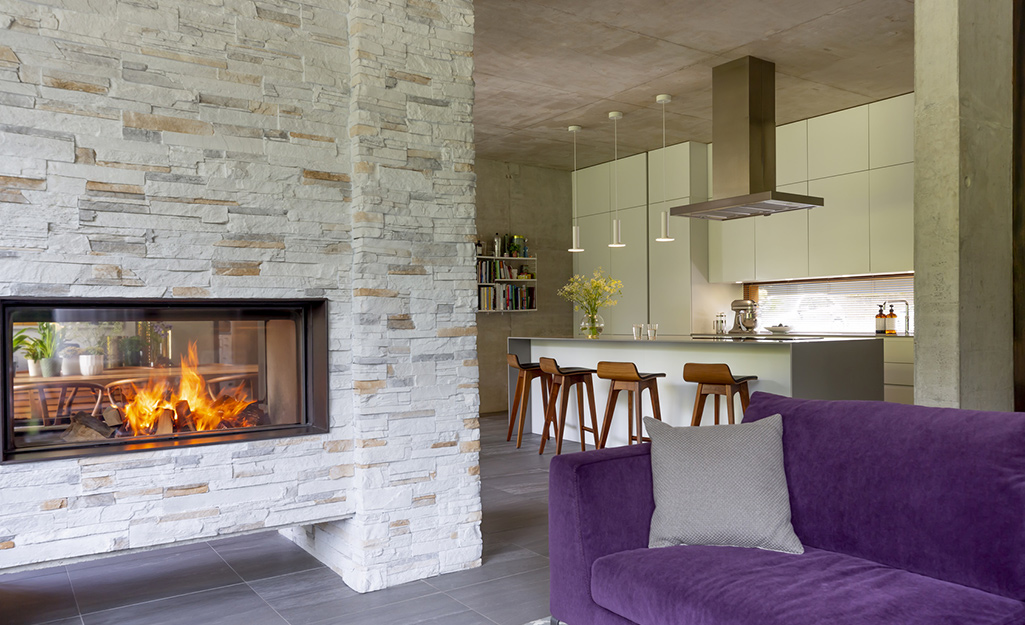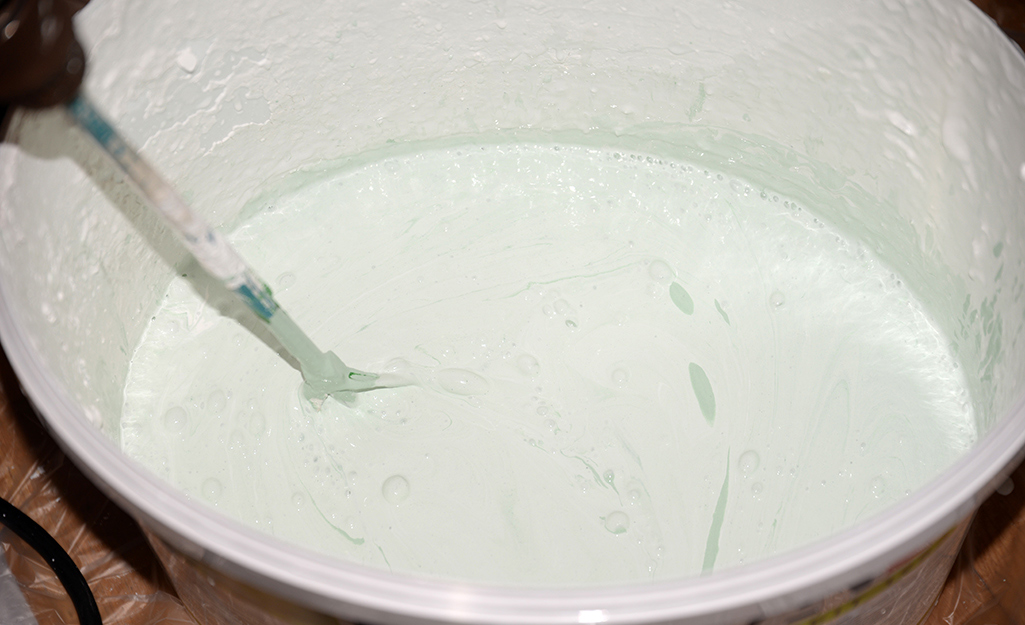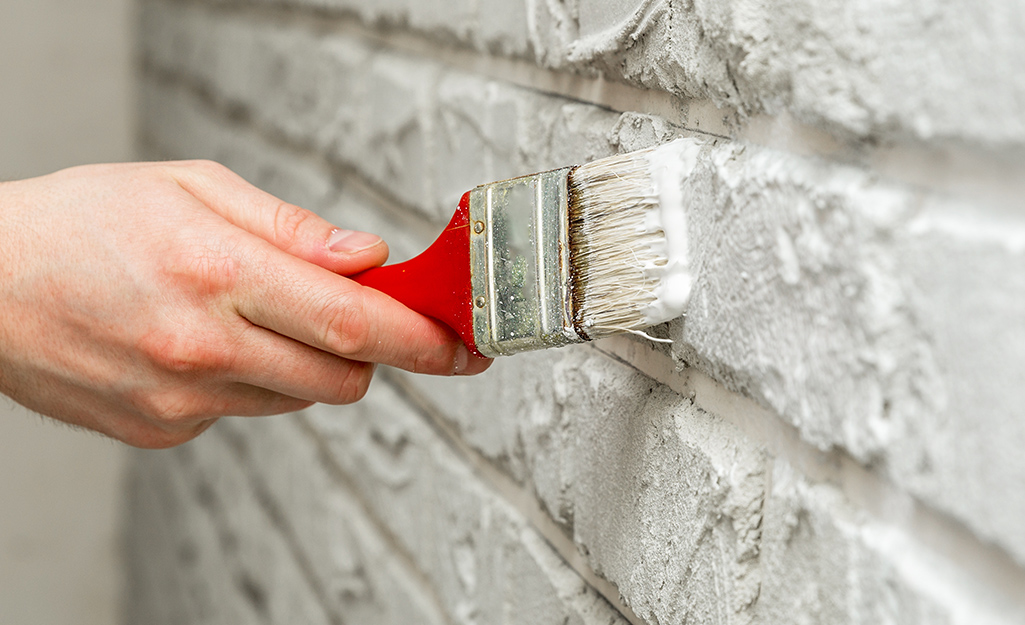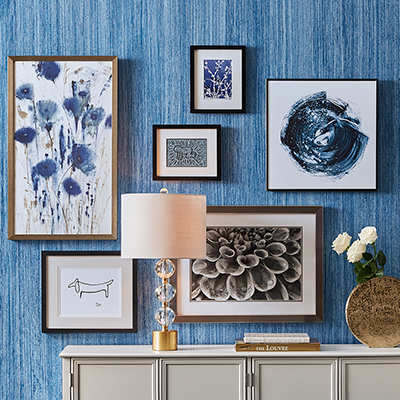How to Whitewash Brick

Last updated September 7, 2023
Brick walls or fireplaces inside your home can be quite charming. They may also make a room or space appear dated or dark. As you learn how to whitewash brick, you can enhance a wall or fireplace. Whitewashing can update your space and make it brighter.
This guide will show you how to whitewash brick. To lighten up your home’s interior, whitewashing brick is an easy alternative to painting.
Difficulty:
Beginner
Duration:
Under 2 hours
Table of Contents
What is Whitewashing?
Clean the Brick
Protect the Workspace
Mix the Whitewash
Apply the Whitewash to Brick and Mortar
What is Whitewashing?

Though the technique is similar, whitewashing is not painting. When you apply 100 percent latex paint to brick, you cover it completely in an opaque color. None of the original red will be visible after you apply coats of brick paint.
What is whitewashing? It’s a technique of applying watered-down paint. Whitewashing covers the brick with a translucent white coat. Whitewash allows the texture of the brick to show through, while covering most of its red color.
You can adjust the thickness of the whitewash to control how much of the original brick color remains visible. A heavier coat of whitewash will cover more of the red brick. A lighter coat will allow more of the original brick to show through.
As you learn how to whitewash brick, you may hear references to limewash. Made of lime that is slaked and aged, limewash is a paint that can be used for a whitewash effect. Limewash sinks into porous materials like brick. It creates an antiqued whitewash finish similar to styles seen in historic Europe.
Because it’s made with natural ingredients and pigments, limewash is environmentally friendly. In addition to white, limewash is available in gray and beige tones.
Clean the Brick

You will get better results when you apply whitewash to clean interior brick instead of dirty brick. Despite its rough exterior, brick can be damaged if it’s washed too hard. Use a light touch as you work.
- Use a dry mop to remove dust from spots on the wall or fireplace you can't reach.
- Apply a cleaning solution of dish soap or all-purpose cleaner and water to the brick with a clean cloth or rag. Gently wash the brick and mortar with a scrub brush. Let the brick sit for 10 minutes. Rinse using a fresh rag dipped in warm water.
- If dirty spots remain, try cleaning them with a solution of one tablespoon of boric acid and a gallon of water. Apply to the trouble spots with a scrub brush. Wear protective gloves and safety googles.
- If you’re whitewashing on or around a fireplace or chimney, be sure to remove any traces of soot. Use a cleaning foam if warm soapy water is insufficient.
- As you clean, check the mortar for cracks. You should fix any defects in the mortar before you begin whitewashing brick.
Tip: If the brick shows traces of old paint, be sure to remove it with a putty knife or paint scraper.
Protect the Workspace

When you’re whitewashing brick, you don’t want to accidentally whitewash your floors or furniture, too. Before you begin whitewashing, protect the space where you’ll be working.
- Move any furniture that’s nearby. Cover any furniture that’s too heavy to move with a drop cloth. If you’re working in the kitchen, cover the counter and appliances.
- Put down a drop cloth on the floor.
- Use painter’s tape to keep whitewash off of protected surfaces.
- If whitewashing a fireplace or chimney, cover the mantel. To keep your fireplace in good working order, don’t whitewash inside the fireplace or chimney.
Mix the Whitewash

Historically, whitewash was made from lime. Limewash is still available, but you can create your own DIY whitewash.
- Mix a 50/50 solution of water and white latex paint. Stir until the mix is even. Avoid using oil-based paint. It does not mix as well with water.
- Test the whitewash. Apply a little whitewash to a brick in a less visible spot on the wall or fireplace. Give it some time to dry and see how you like it.
- If you want heavier coverage, add more paint to your solution. If you want a lighter look, add more water.
- Brick is porous, so the whitewash may fade a little as it soaks into the surface.
Apply the Whitewash to Brick and Mortar

- Begin by lightly misting the brick with water from a spray bottle.
- Apply the whitewash with a wide paint brush. Lightly dab it with a cotton cloth as you go. Be sure to wipe off any drips you may leave.
- Work in a small area so you can stay in control of how much whitewash you apply and wipe off.
- An alternate method is to use a cotton cloth to apply the whitewash to the brick.
- Leave as much or as little whitewash in place as you prefer. Some people like a more uneven, shabby chic look.
- The porous brick will absorb the whitewash as it dries, so the brick may appear whiter than you want at first.
- If necessary, use a narrower paint brush to whitewash the mortar, the edges of the brick and any other spots that might be hard to reach.
- Let the whitewash dry overnight.
- The number of coats of whitewash you’ll apply depends on your preference. You might like the way it looks after only one coat. If the first coat doesn’t suit you, add a second or even third coat.
Tip: A modern method called “German smear” creates a whitewash effect by mixing 70 percent mortar and 30 percent water. Apply the thicker mixture with a trowel or grout sponge and then remove enough to leave a thin coating. Wear a protective mask and safety glasses.
When you know how to whitewash brick, you can give a brick wall or fireplace a contemporary makeover. You can make your own whitewash by mixing latex paint and water. To get a historic look, use premade limewash, which is also an environmentally friendly approach.
Ready to start whitewashing brick inside your home? The Home Depot delivers online orders, when and where you need them.



























